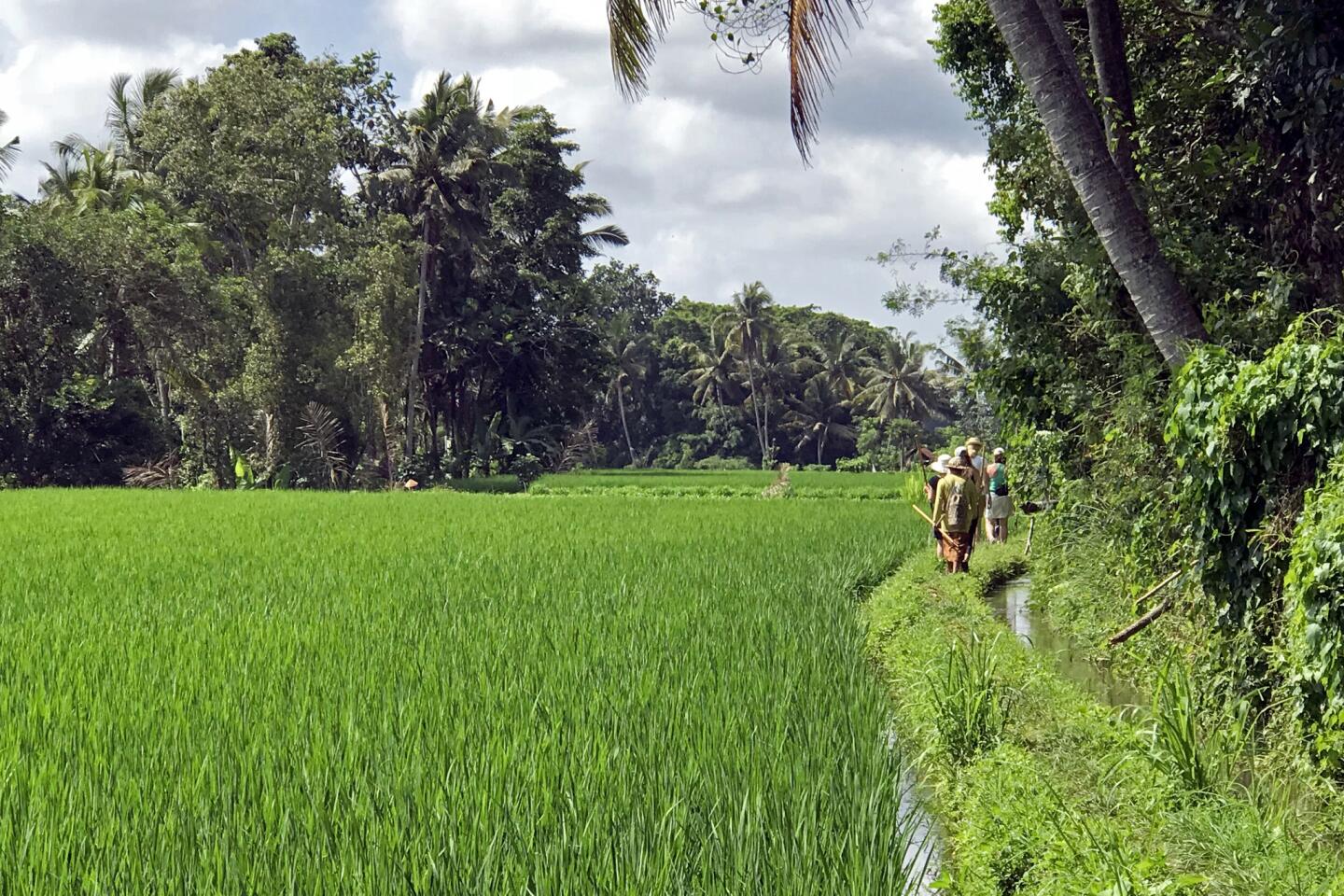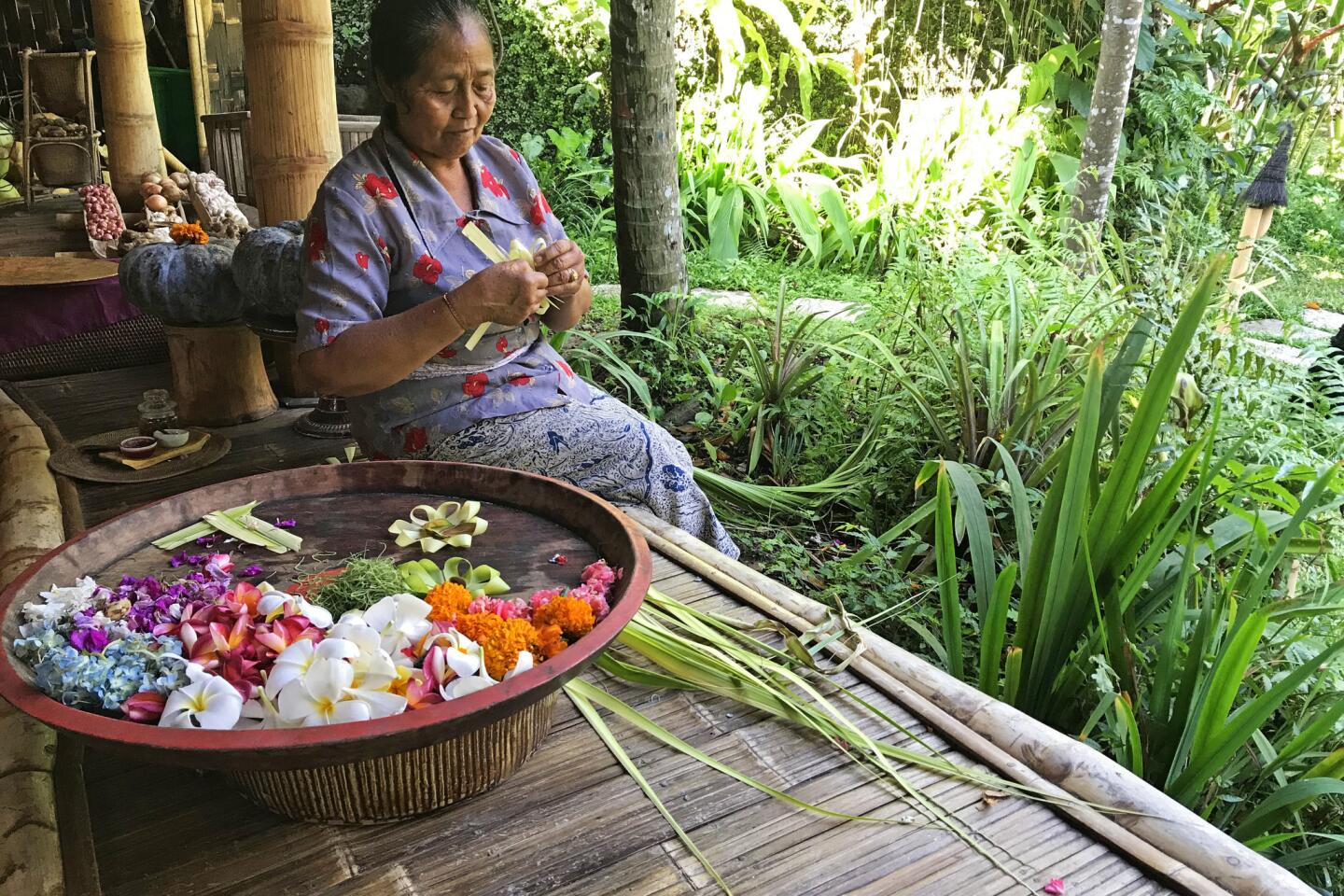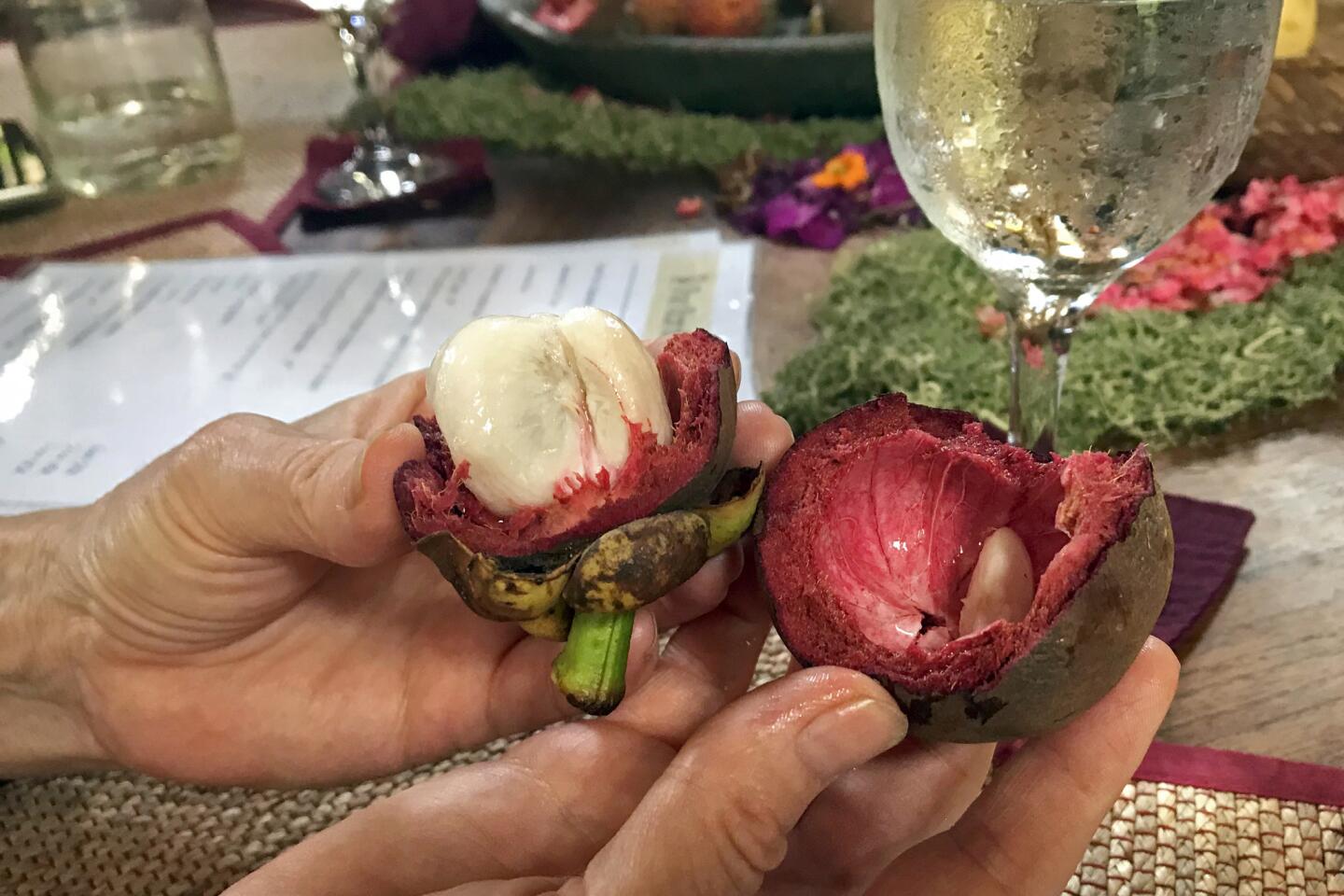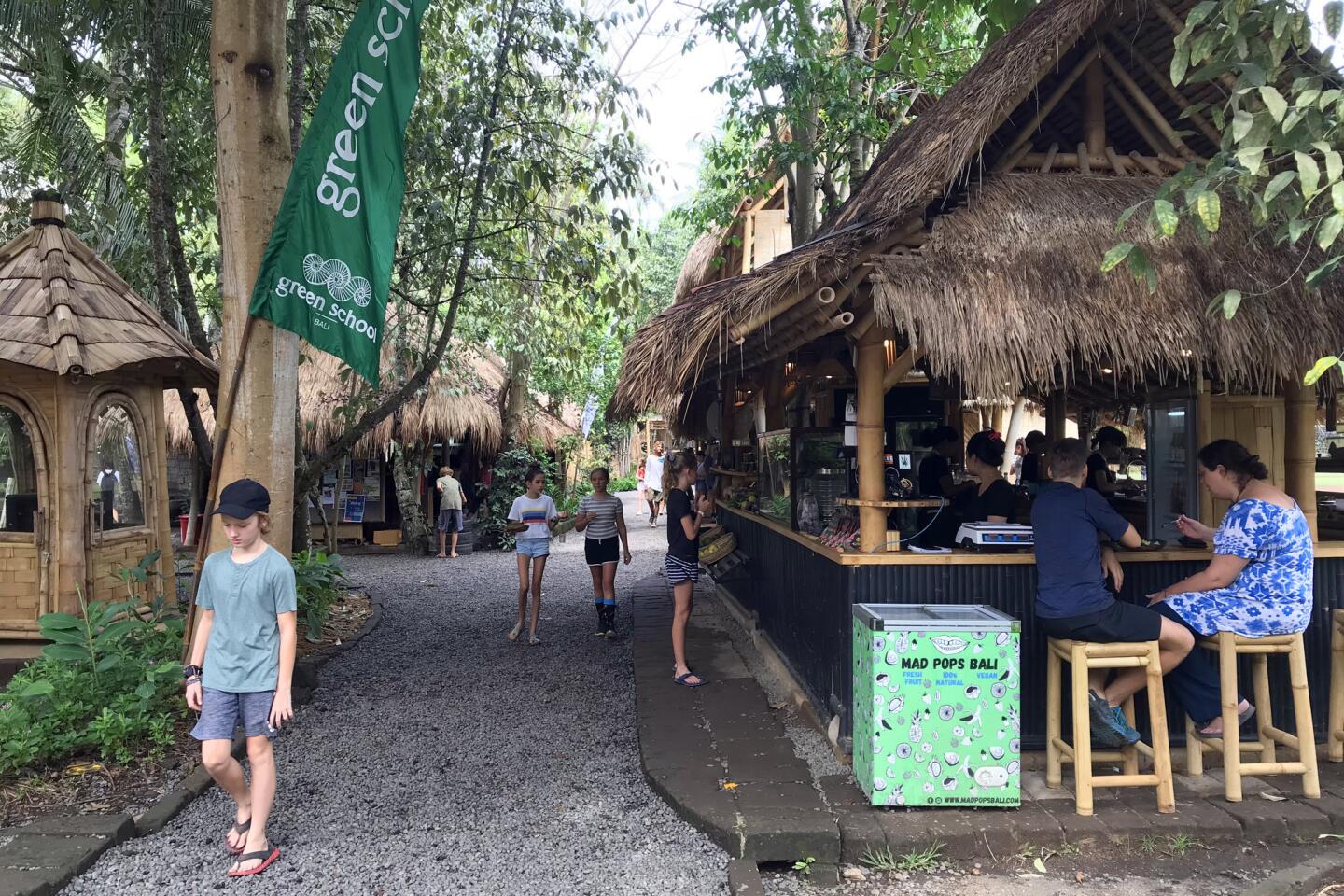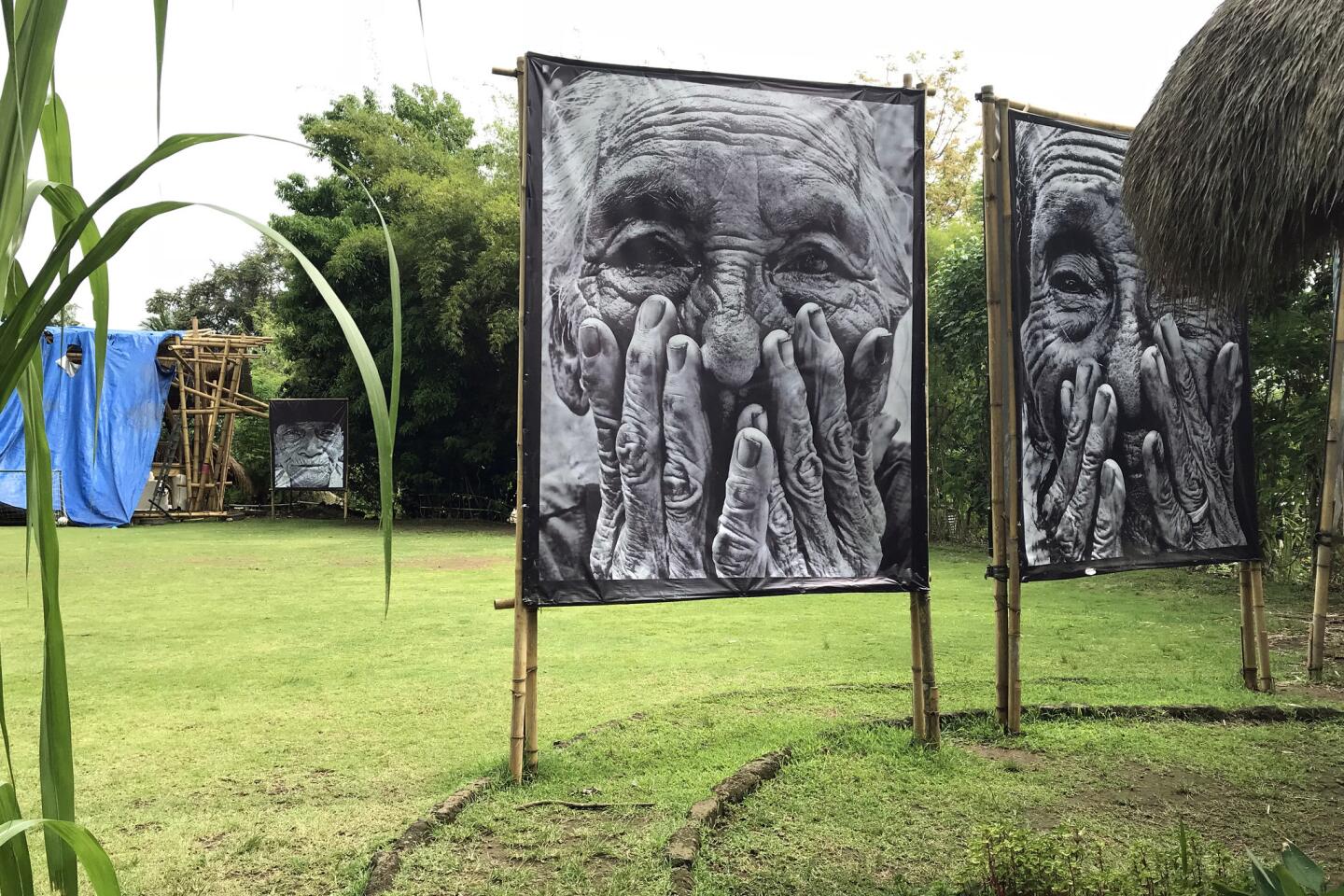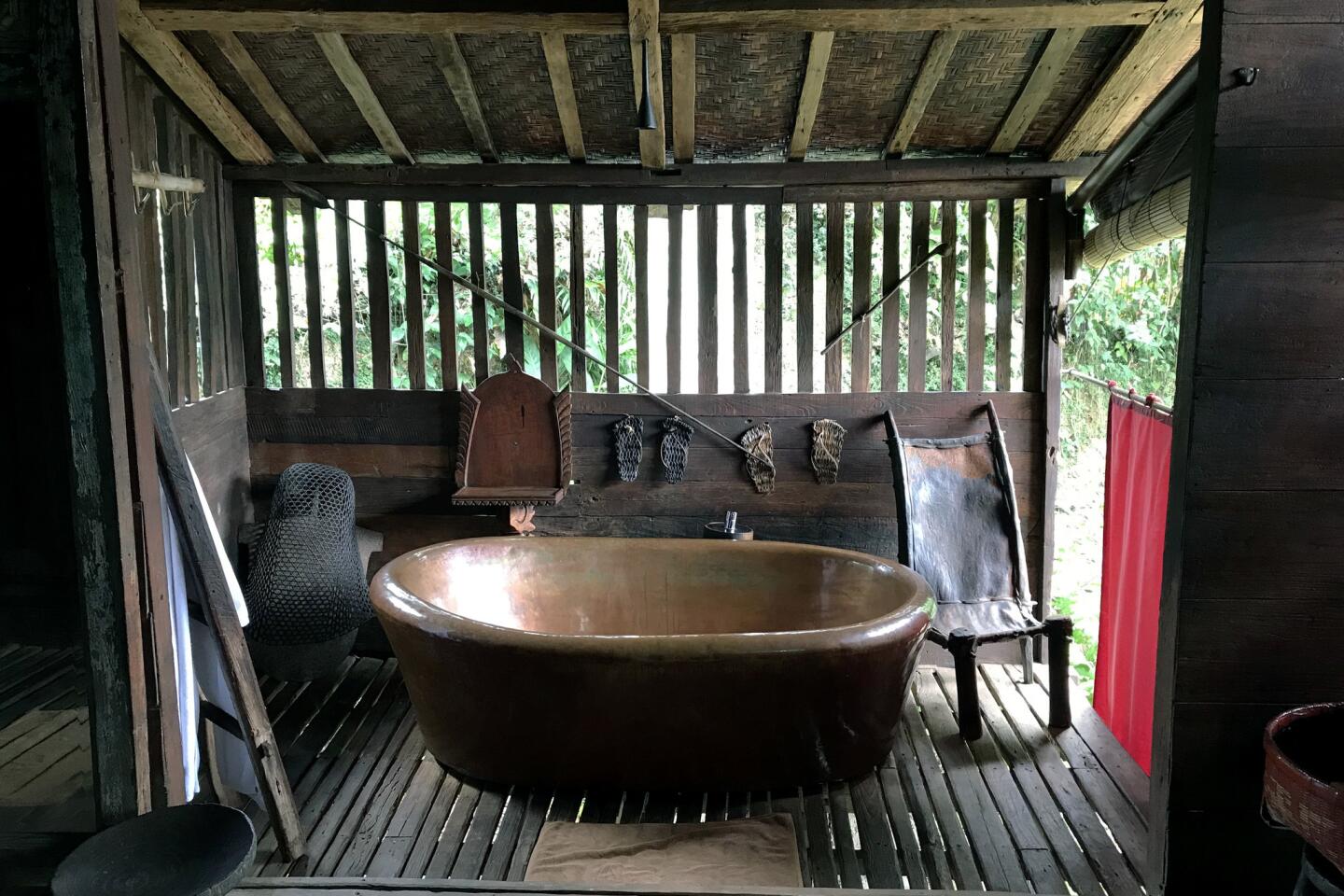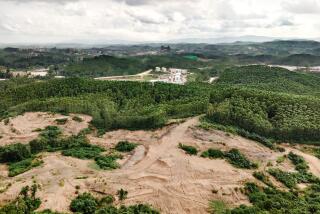A Bali vacation sounds magical — and it is when you help keep the island beautiful
Reporting from Ubud, Indonesia — Given the situation, I was moving as fast as I could.
I was walking cautiously on a foot-wide earthen berm separating water-soaked rice paddies. A big cross-body garbage bag banged against my hip as I clutched a 6-foot pole with a pointed metal tip.
Rivulets of sweat ran down my back as I speared yogurt cups, candy wrappers and plastic bags.
And then I lost my balance.
It was our first full day on the Indonesian island of Bali, and nine of us were on a “trash walk” near the upland town of Ubud in the heart of the island. The walk was organized by Cynthia Hardy, a friend who had invited us to Bali. She moved to the island in the ’80s and has been here, on and off, ever since.
With Cynthia in the lead, we traipsed through terraced green rice paddies, along slippery brown riverbanks and centuries-old waterways in search of demon trash. We picked our way past men, women and children bathing and frolicking in the irrigation canals, the heart of the Balinese irrigation system known as subak, so unique that UNESCO has designated it a World Heritage site.
Toward the end of our walk, we came upon a woman selling durian, a football-size fruit with a hard, spiky shell that has been outlawed on public transportation all over Asia because of its noxious smell. Cynthia bought one, broke it open and tried to entice us to eat the fruit, whose scent is a nauseating mixture of sweaty socks and rotting garbage. If you can get past the smell, she assured us, it tastes like a stick of Juicy Fruit gum.
I tried, but gagged and had to spit it out.
Price of popularity
For the American traveler, the word “Bali” conjures up a lush image of magic, spirituality and possibilities. It’s an island of Hindu gods and temples in a nation with the largest Muslim population in the world.
What is usually missing from the Bali of our imaginations is the reality of an island struggling to maintain its identity even as it has become a tourist haven — and the rare target for Islamist terrorists.
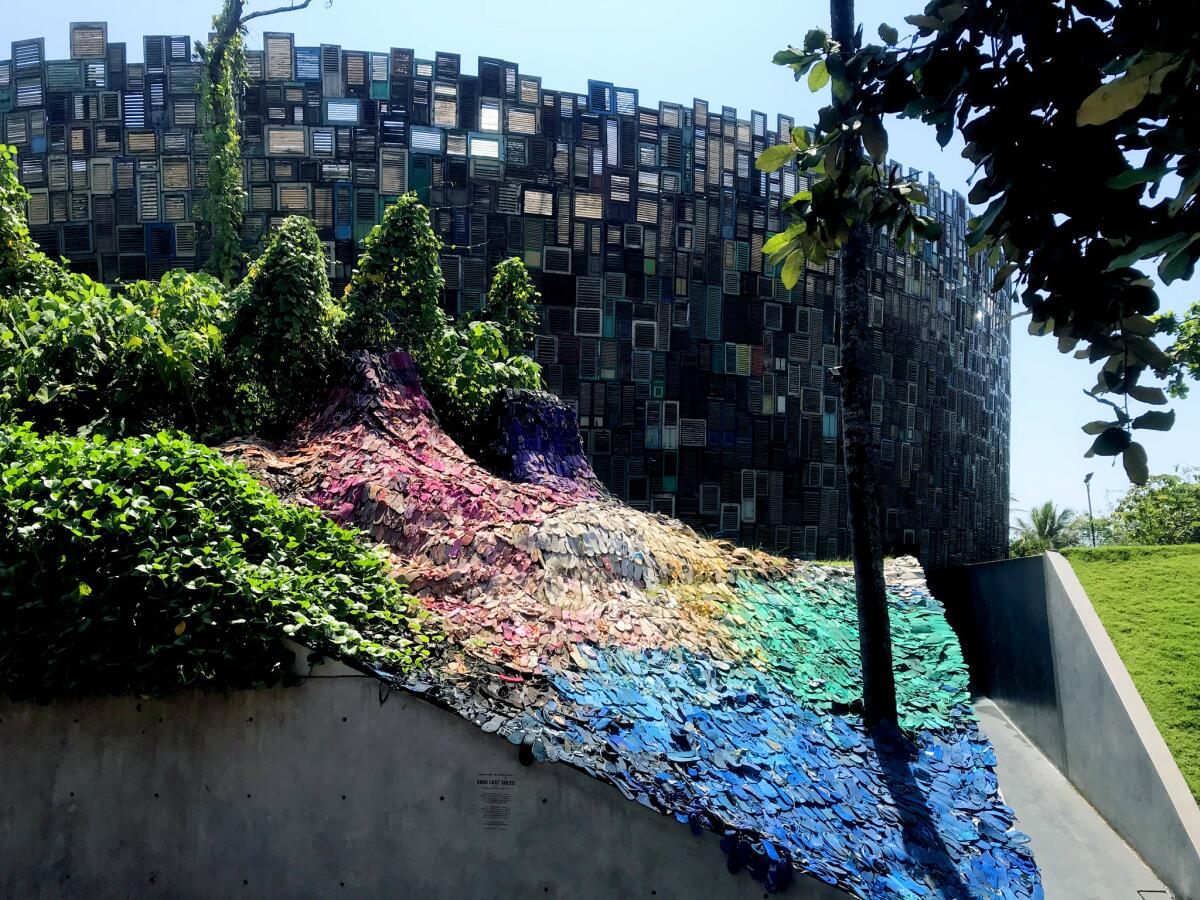
New wealth has meant that Bali’s roadways are overrun by motorbikes. Its waterways and rice paddies are choking on trash that has turned this once pristine island into a cautionary tale about the perils of plastic and consumption in an agrarian society ill-equipped for the challenge.
You can overlook the problems or engage with them, as we tried to do on our trash walk. But however you experience Bali, you will be intoxicated by its charming and spiritual people, its intense beauty, and its tropical mélange of fecundity and decay.
Drums in the night
My nine-day visit to the island in November was unusual, but anyone can replicate the itinerary.
I went to Indonesia because of my friendship with the Hardys; however, I paid for my accommodations, airfare and the rest of my trip, in keeping with Times policy.
Nine women, most of them friends of Cynthia’s since her childhood in Marin County, had come to visit the place she has called home for 30 years. We put ourselves in her experienced hands, and she arranged treks, day trips, shopping outings, dinners and, of course, yoga classes.
We were all eager to know more about Bali, and about the multifarious world that Cynthia and her husband, John, have created here, all in the cause of promoting sustainability and an appreciation for the world’s natural balances.
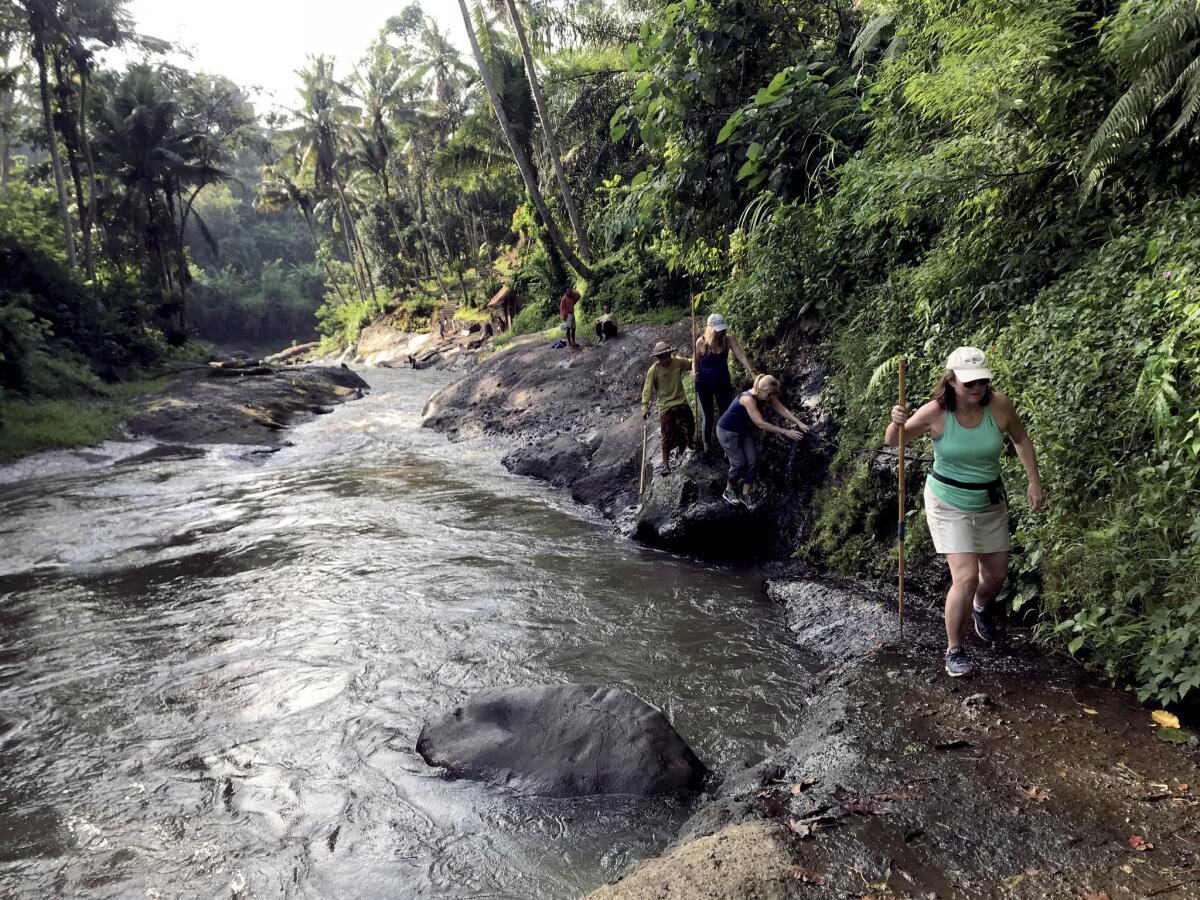
The Hardys first became known for their jewelry business, which John founded in 1975. A tour of the workshops and design center was high on our to-do list. The company employs hundreds of Balinese artisans who make the distinctive John Hardy woven bracelets, earrings and necklaces sold in high-end stores around the world.
After our tour, we sat down with some of the company’s employees in a long bamboo pavilion for a lunch of corn fritters, fish wrapped in banana leaves, salad, rice and banana cake. Happy and full, we meandered into the boutique, a 90-foot-tall bamboo marvel that looks like a ship’s hull and appears to float on rice paddies. Let’s just say some of us were less restrained with our credit cards than others.
About a decade ago, the Hardys sold the business, which gave them the means to create the eco-centric luxury hotel Bambu Indah, the private Green School, and Green Village, a small community of spectacular, custom bamboo homes designed by John’s daughter Elora Hardy.
Bambu Indah hotel is built on a ridge overlooking the Ayung River, its 2½ acres dotted with vegetable gardens, coconut and frangipani trees, and rock-lined pools that look like natural ponds.
The accommodations consist of 11 antique Javanese bridal houses, charmingly rustic but with fridges, AC, good lighting and plumbing. A couple of new bamboo cottages, designed by Elora Hardy, are secluded below the main level, perched on the river and surrounded by jungle.
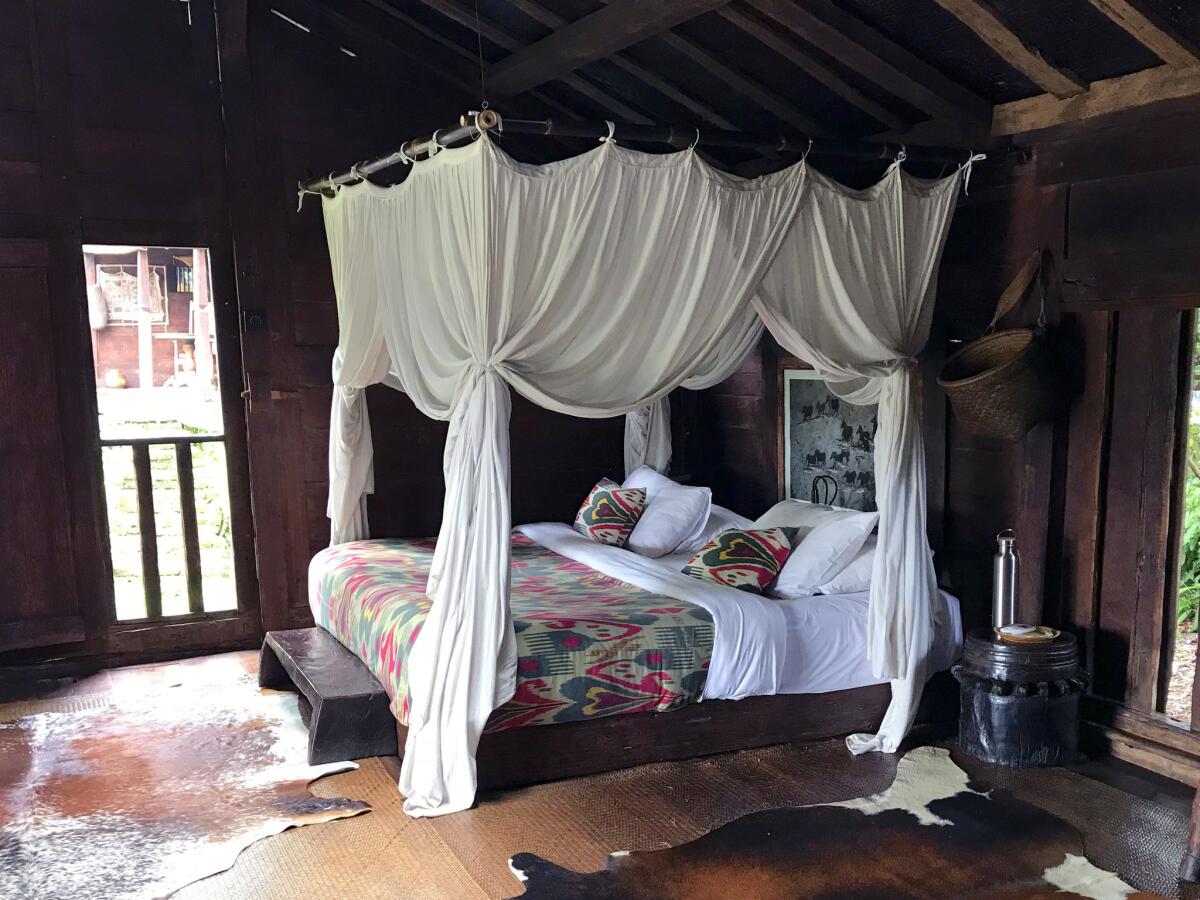
Before dinner one night, I was lolling in my spacious cottage, Afrika House, ensconced behind white muslin bed curtains, safe from mosquitoes.
The frogs were just starting their nightly arias when the rhythmic sound of bells and drums wafted into my room. The mysterious sound would swell, subside, then rise again. I felt as if I were being summoned by some ineffable force.
I wandered into the hotel’s open-walled restaurant, where I found a dozen or so Balinese musicians sitting on the floor making hypnotic music with metallophones, which look like xylophones; bonangs, which look like brass kettles; and drums. It was a traditional Balinese gamelan orchestra. The percussive music was ethereal.
As we sat down at a round table for 10, servers and cooks fussed nearby with a whole roasted pig on a spit. (We hoped it was not one of the black Balinese pigs we had met earlier in the week on one of our walks, but Cynthia could give no guarantee.)
After we finished our feast, the orchestra accompanied a topeng dance in which elaborately costumed dancers in grotesque masks acted out Balinese folk tales.
Even without knowing the stories, it was easy to see that good triumphed over evil.
Paddling through the caves of Phang Nga Bay and making sure they are preserved for the future »
Ikat and dyed roosters
Most visitors do not rent cars on Bali and instead hire drivers, easy to do through hotels and local companies. This is the safest choice, because Bali streets are choked with motor scooters — sometimes carrying families of four — and driving is on the left side. The obstacles on any given road — trucks, tour buses, vans, dogs, chickens and the occasional cow — make driving daunting.
One day, our Bambu Indah drivers took us from Ubud to Karangasem, a two-hour drive to Bali’s east coast, where we planned to spend one night.
On the way, we visited the ancient village of Tenganan, whose residents are known as Bali Aga, or original Balinese. Theirs is a closed society; you can live in the village only if you were born there. If you marry an outsider, you must leave.
There was a small fee (about $1) to enter the village, which was laid out along a wide, grassy path. The homes on either side doubled as workshops and stores. Inside one, we watched women weaving double ikat fabric, an ancient, painstaking process that produces exquisite fabric highly valued by textile collectors.
The prices were astronomical — $600 for a length of ikat about the size of a long, wide scarf — so I bought some fine-gauge rattan baskets and hollow eggs painted with Hindu gods instead. The eggs were carefully wrapped and gently placed in woven bamboo boxes, perfect for gifts.
As we strolled around the sleepy village, we saw roosters dyed hot pink and electric blue, captive under bell-shaped woven bamboo cages.
“Why?” I asked a man sitting next to one.
“Just for fun,” he responded in English, which is partly true, I suppose.
The roosters are combatants in the blood sport of cockfighting, I later learned, illegal in Bali but still widely practiced.
‘Banana-leaf mentality’
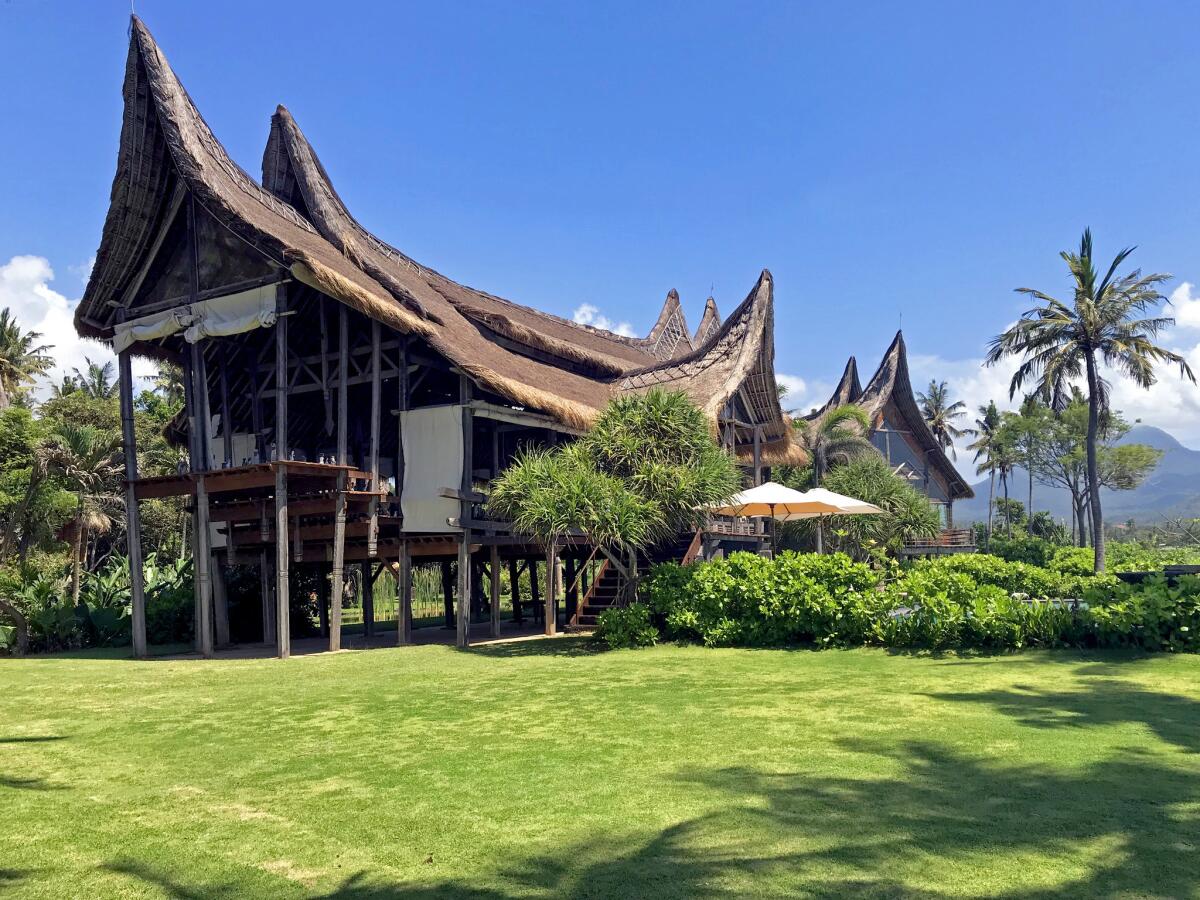
We arrived late in the day in Karangasem, where we stayed at Villa Campuhan, a beachfront complex of six villas and a longhouse on the Lombok Strait. It is owned by director Rob Cohen, whose movies include “The Fast and the Furious” and “DragonHeart.”
Cohen was drawn by the excellent surf break and the dramatic view of Mt. Agung, an active volcano that plays a central role in Balinese spirituality. (When we sat on mats during our welcome ceremony at Bambu Indah, Cynthia instructed us not to point our feet toward the mountain, a sign of disrespect.)
Cohen built the place for his family but now rents it out. Visitors can book one villa or the entire complex. A staff serves meals, and there is a small spa for massages.
Over a dinner of grilled shrimp and rice, we were joined by American ex-pat Emerald Starr, a friend of Cohen’s who helped oversee the construction of Villa Campuhan.
LETTERS: Writing about a place that’s too well-loved does it a disservice »
The heart of the place — an ironwood, open-walled longhouse elevated on thick stilts — is based on a traditional Sumatran design, he told me, with a swooping roof line that evokes the horns of a water buffalo.
In the morning, Starr led us on another rice paddy trek, where we bumped into a farmer planting his crop. The man was bent at the waist, calf-deep in water, shooting baby rice plants like darts into the muddy water.
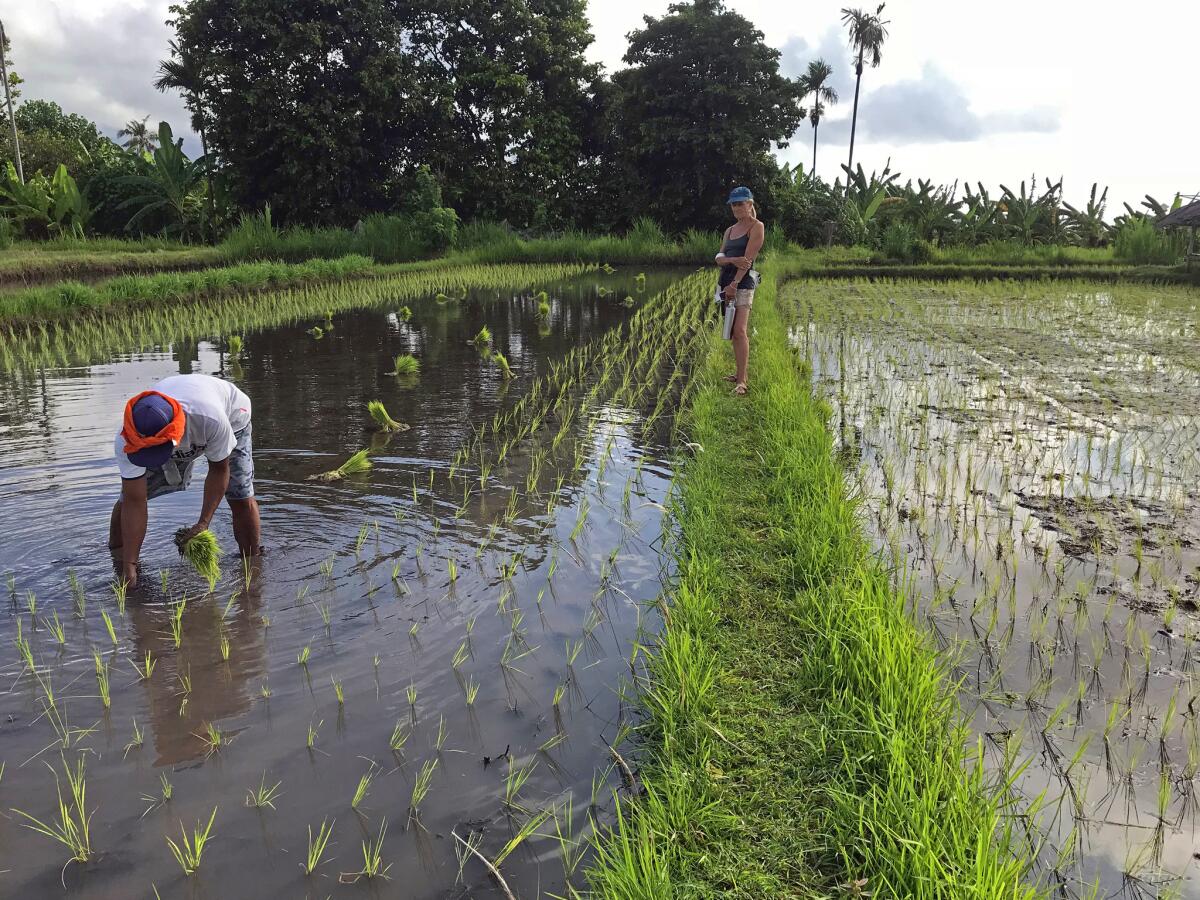
Again, we saw too much trash in the waterways that fed the paddies. Starr, a gentle soul with a vast knowledge of Balinese culture, said he considers the proliferation of plastic the legacy of the island’s “banana-leaf mentality.” Traditionally, Balinese food was wrapped in banana leaves — unwrap and toss. The wrappers have changed; old habits have not.
“When you come to Bali,” Starr told me, “one of the first things people ask you is, ‘What are you doing here?’ They want to know how you are contributing.”
He showed us what he is doing for Bali that afternoon when he took us to Sorga, his organic chocolate company.
Starr’s triple-fermented dark chocolate bars were fruity with multiple layers of flavor, and you can buy them only on Bali. Sorga, which means “heaven” in Balinese, is part of a domestic chocolate explosion. Most of the country’s cacao crop is exported, but increasingly, producers make high-quality chocolate for Indonesia.
A swing into a pool
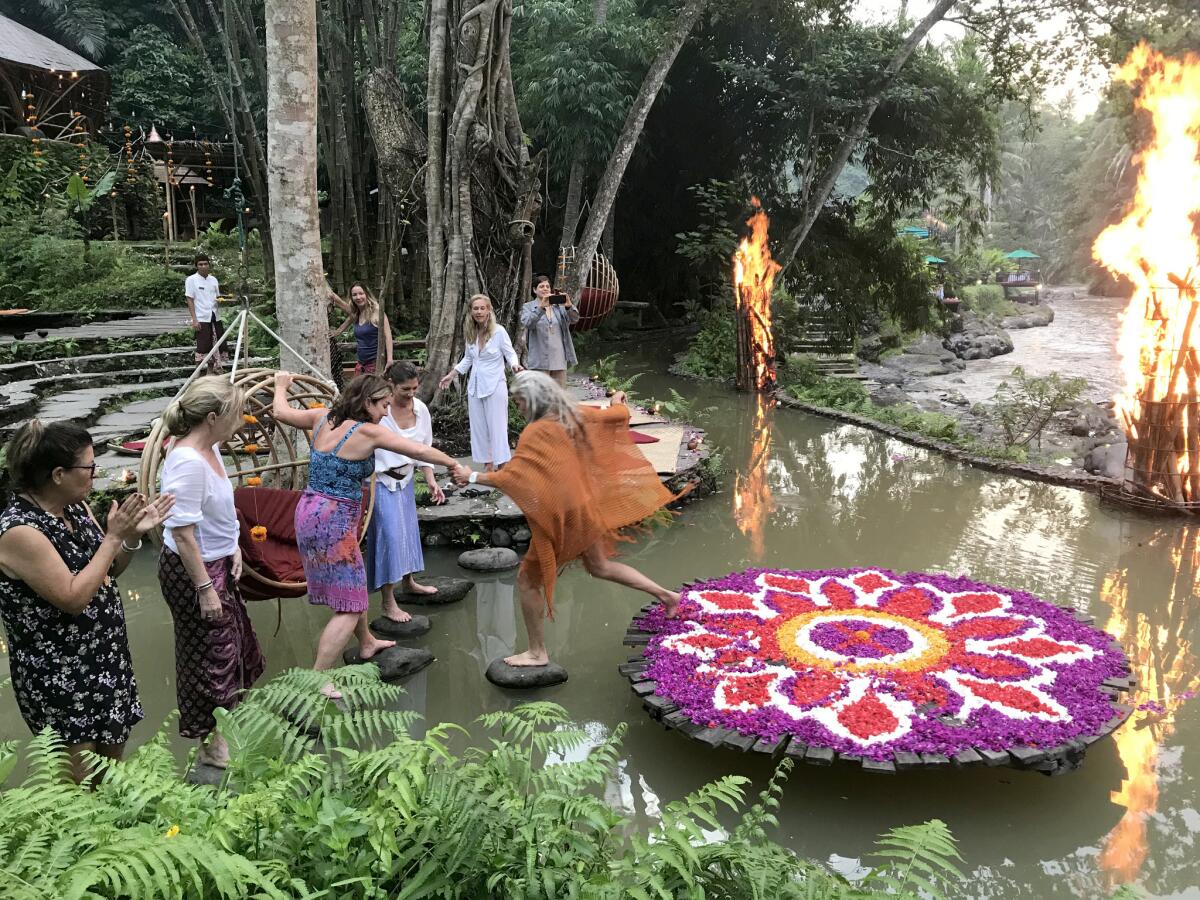
As it turns out, falling into a rice paddy is more embarrassing than dangerous.
You just pull your leg out of the muck, hope your shoe is still on your foot, and get on with it.
At the end of our first trash walk, a three-hour expedition that left most of us soaked in sweat and feeling as if we’d done just a tiny bit of good for Bali, we made our way back to the riverbank below the main Bambu Indah complex.
Here, at the river’s edge, the Hardys have built natural-looking rock-lined swimming pools that seem to be part of the jungle. Some of us dangled our feet in the water, some stood under a gentle waterfall. The bravest took hold of a rope swing and plunged into the pool.
Servers brought us bubur, a traditional Balinese breakfast of rice, vegetables and peanuts wrapped in a banana leaf. We scooped up the delicious concoction with our fingers, tossed the leaves aside and slipped into the water to cool off.
If you go
THE BEST WAY TO BALI
From LAX, Cathay Pacific, Delta, China Southern, China Air, Singapore, Qatar, Hong Kong, EVA and Philippine offer connecting service (change of planes) to Denpasar airport. Restricted round-trip airfare from $866, including taxes and fees
To expedite customs on arrival at the airport, you can buy a Fast Track pass through the website Bali Concierge. For about $28, you will be met at the gate, escorted to a lounge to wait while your luggage is collected, then whisked through customs.
WHERE TO STAY
Bambu Indah, Banjar Baung, Ubud, Bali, Indonesia; bambuindah.com. In peak season, June 15 to Sept. 30 and Dec. 15 to Jan. 5, cottages range from $185 to $745 a night. A new room, The Tent, is popular with the budget-conscious Instagrammers. It’s a secluded circular bamboo platform beneath a retractable domed mosquito net.
Villa Campuhan, Jalan Pura Mascima, East Bali, Karangasem, Bali, Indonesia; villacampuhan.com. From $175 a night.
WHERE TO EAT
Bambu Indah Kitchen Restaurant, Bambu Indah hotel Traditional Balinese food, prepared from the hotel’s gardens and livestock. Breakfasts, including the fruit and acai bowl and traditional rice-and-vegetable dish called bubur, are a highlight.
Batubara, 108 Jalan Raya Pengosekan, Ubud, Bali, Indonesia; facebook.com/batubaragrillery Argentine restaurant with excellent wine and tasty cuts of beef, to be finished on tabletop braziers. Dinner and wine, about $40 per person.
WHAT TO DO
John Hardy jewelry factory & design studio, [email protected]. Watch Balinese artists and metalworkers create the signature John Hardy woven silver. Tours, by reservation only, end with a traditional Balinese lunch with company executives and artisans. Free.
Tenganan. An ancient village where time-honored Balinese craftsmanship is celebrated and honored.
Sorga Bali Chocolate, Jalan Pura Mastima, Karangasem, Bali, Indonesia. Ex-pat Emerald Starr offers tours and tastings of his high-quality dark chocolate made from Bali cacao.
More to Read
Sign up for The Wild
We’ll help you find the best places to hike, bike and run, as well as the perfect silent spots for meditation and yoga.
You may occasionally receive promotional content from the Los Angeles Times.
